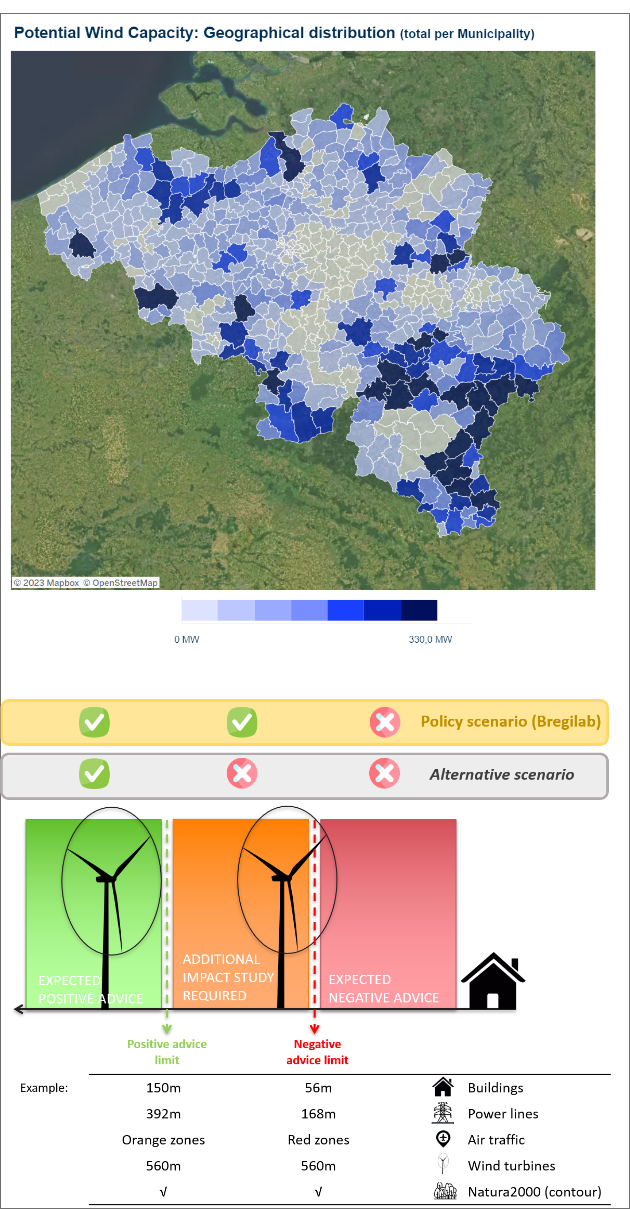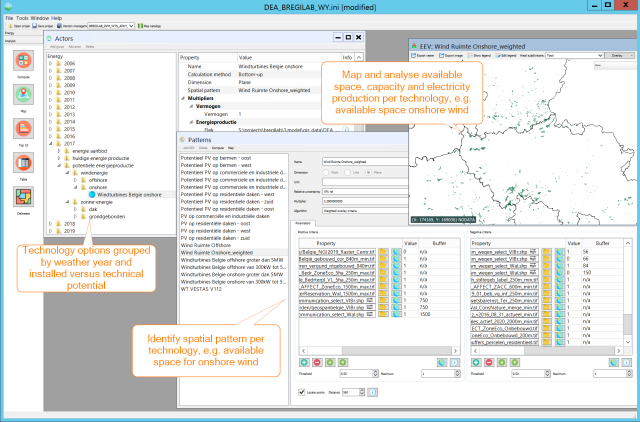Dynamic Energy Atlas
DEA is an in-house developed software based on underlying spatial models that map and model energy demand and potential.
The model relies on a generic formula that multiplies a spatial pattern with an energy factor.
The energy factor refers to the amount of energy consumed or produced at a specific location. For a wind turbine for example, this refers to the capacity of the turbine and combines it with wind speed maps to assess the amount of energy produced in a year or even per hour.
To produce the spatial patterns, the Dynamic Energy Atlas is equipped with a set of spatial allocation algorithms. Such an algorithm is intended to define areas where a specific technology, such as large scale wind turbines for example, can be deployed. It enables the user to enter and compile two stacks of map-layers (see illustration), one representing the positive spatial criteria facilitating the deployment of the technology, and, a second representing the negative spatial criteria prohibiting the deployment. Criteria are a selection of physical, environmental, spatial planning or legislative characteristics of the study area, each available as a GIS map-layer.
Multiple allocation algorithms are available to fit for multiple technology types and multiple energy demand actors. More advanced analytical tools even include optimization algorithms including cost benefit calculations.
Finally, the model results in energy demand and (potential) production maps, which can be consulted and exported for individual actors or technologies, but also for groups of actors and technologies. The maps are calculated a high level of detail, up to 1m resolution (depending on the size of the study area). Aggregations can be made at any administrative or other spatial level desired. Spatial filters of various sorts can be applied on the raster maps in order to bring to the surface ‘hot spots’ of energy demand or production that otherwise are lost in the detail of the raster representation.
Why working with DEA?
The Dynamic Energy Atlas is used among others to:
- monitor the current energy demand and renewable energy production in the region and also its evolution through time
- assess the unexploited potential for renewable energy based on wind, solar, biomass, geothermal and hydro power and monitor progress with respect to municipal, provincial and regional climate plans in compliance with the EU climate and energy objectives and the objectives defined in the Covenant of Mayors;
- assess the potential for heat exchange and heat networks in compliance with article 14 of the EU guideline 2012/27/EC concerning energy efficiency;
- design and implement policies aimed at the development and exploitation of energy landscapes with due consideration of spatial planning and environmental constraints;
- define and implement regional and provincial legislative frameworks with respect to wind energy.
For each form of energy, be it electricity, heat, or fuels, the DEA produces maps of the demand per (sub-)sector, and the production per (sub-)technology at the level of cells in the raster as well as on spatial entities selected by the user which are a multiple of the cellular units. The DEA also produces reports of totals, by technology, by industry, by cell or group of cells, ...
The DEA is an important decision support system for governments, producers, distributors and (big) consumers of energy. The DEA gives a better insight in on-going and future transitions and anticipate and judge effects on their role in the system. This is certainly the case when assessing the potential of new locations for producing renewable energy.
We deploy DEA both as a product and as a service. Parties with a repetitive demand and a desire to perform the recurring analyses themselves can use DEA as a product, guided by a customised training. Parties with a demand for exploratory and research-oriented analyses and scenarios can use DEA as an input model in the framework of a service provided by VITO.


